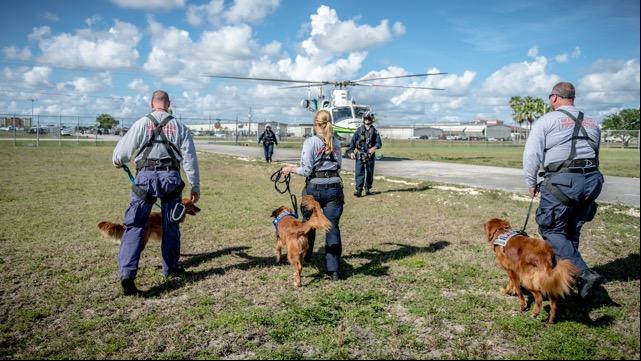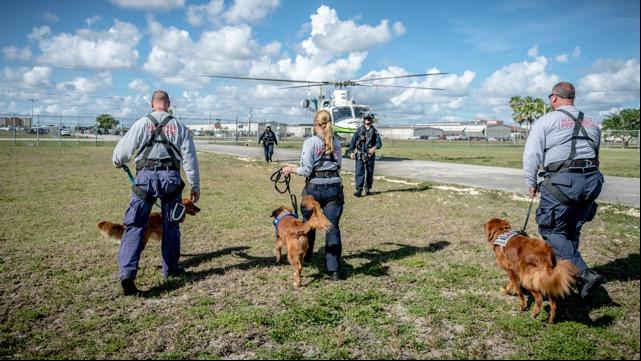
Credit: Erin Perry
URBANA, Ill. – When disaster strikes, you want the very best tools, functioning at their peak. In the case of catastrophic earthquakes, tornadoes, or even bombings in war zones, those tools are search and rescue dogs. But researchers have found that getting dogs to disaster sites can add to the animals' stress.
"We've spent $16 billion in this country trying to come up with a machine that can sniff better than dogs, and we haven't done it yet. Search and rescue animals can save lives, protect our soldiers in the field, and locate survivors after a disaster. We want to know how we can manage them so we can protect their performance, because their performance impacts human lives. That's the reason behind what we do," says Erin Perry, an assistant professor in the Department of Animal Science, Food and Nutrition at Southern Illinois University.
Perry, who has also been a canine handler in the Department of Homeland Security for the past 14 years, teamed up with University of Illinois animal scientist Kelly Swanson and others at U of I to learn how stress affects the animals' performance on the job.
Search and rescue dogs fly on a moment's notice to the site of a disaster, where they are expected to perform at the top of their game. But, just like for humans, flying can be stressful for dogs. The research team designed two preliminary studies to evaluate the effect of air travel stress on the animals' physiology and job performance.
"Some dogs are like, 'I've flown before, no big deal,' but others, even if they've flown before, still show stress behaviors, and can have elevated body temperature or diarrhea," says Swanson, Kraft Foods Human Nutrition Endowed Professor in the Department of Animal Sciences and the Division of Nutritional Sciences at U of I.
Dog owners may be familiar with the tendency towards loose stools when their animals are stressed. One of the reasons for that may be a stress-induced change in gut physiology and shift in the gut microbiome, the community of microbes that inhabit the mammalian gut. Paired with a more permeable [or leaky] gut lining, also triggered by stress, "bad" microbes can gain an advantage and cause upset stomachs. These symptoms have been observed in search and rescue dogs when traveling to a work site, but no one had ever studied the dogs' microbiome.
In one of the studies by Perry and Swanson's team, search and rescue dogs were flown for 2.5 hours in the cabin of a commercial airliner to the job site. In the other, dogs were "hot loaded" into a helicopter – blades whirling – for a quick 30-minute flight to the site. The team looked at slightly different factors in each study, but for both, they examined changes in the makeup of the microbiome and performance on the job.
The helicopter flight caused spikes in body temperature and the stress hormone cortisol, but the researchers didn't observe changes in the makeup of the dogs' microbiomes. Dogs that entered an airport, went through security, and flew for a longer period on the commercial flight showed an interesting microbial shift.
"Microbial beta diversity, which is a measure of the presence and abundance of bacterial taxa, was different between dogs that traveled compared to those that did not. Travel led to greater relative abundances of Clostridia and Bacteroidaceae populations, two of the more predominant microbial groups in the gastrointestinal tract," Swanson explains. He says more research is needed to understand how such changes may impact the long-term health of search and rescue dogs.
But the most impressive finding in both studies was the fact that there was no effect of air travel stress on the dogs' job performance. "They showed behavioral stress, their gut was completely turned upside down, their bloodwork showed significant effects, and it didn't matter. They still went to work and performed beautifully," Perry says. "Even though we see physiological impacts on these dogs, they're such amazing athletes that they overcome the physical and environmental stress and just do their job."
Although travel didn't impact the dogs' performance in these preliminary studies, the researchers emphasized that stress can occasionally cause search and rescue dogs to miss work. But gaining new insight into canine stress responses, particularly the way stress affects the microbiome, may pave the way towards potential solutions for both working and companion animals.
"We've all owned dogs that were scared of lightning, vacuum cleaners, those innocuous day-to-day experiences," Perry says. "Having a better understanding of what causes stress and how to compensate for it helps every dog, not just the ones that are out there saving lives."
Swanson adds, "These small studies are just a starting point. In the future, we hope to apply these findings to larger studies focused on various stressor types and a longer duration of stress, similar to that experienced in the field during times of emergency. Our goals will be to develop and evaluate nutritional interventions and/or management strategies that avoid negative physiologic effects and maintain performance."
###
The first article, "Effects of air travel stress on the canine microbiome: A pilot study," is published in the International Journal of Veterinary Health Science and Research. Perry (formerly Venable) and Swanson's co-authors are Stephanie Bland from Southern Illinois University and Hannah Holscher, an assistant professor in the Department of Food Science and Human Nutrition at U of I. The study was funded by Southern Illinois University.
The second article, "Physiological effects of stress related to helicopter travel in Federal Emergency Management Agency search-and-rescue canines," is published in the Journal of Nutritional Science. Perry and Swanson's co-authors are Natalie Gulson, from Southern Illinois University, and Tzu-Wen Liu Cross from the Division of Nutritional Sciences at U of I. The study was funded by CANIDAE pet food company and the Louis Stokes Alliances for Minority Participation.
Media Contact
Lauren Quinn
[email protected]
217-300-2435
@ACESIllinois
http://aces.illinois.edu/
Related Journal Article
http://dx.doi.org/10.1017/jns.2017.25





